Accounting Ethics Case: Vroom Ltd, Profit Deferral and Stakeholders
VerifiedAdded on 2023/06/07
|13
|3265
|51
Case Study
AI Summary
This case study examines the ethical dilemma faced by Lucia, an accountant at Vroom Ltd, owned by Freda Chuse. Freda, whose bonus depends on the company's profitability, instructs Lucia to defer revenue recognition to maintain a government grant for apprentice training. The study identifies key stakeholders, including Freda and Lucia, and analyzes the ethical implications of manipulating financial records. It discusses the conflict between maximizing profit and adhering to ethical accounting practices, referencing the APES 110 Code of Ethics. The analysis also covers ethical principles like integrity, objectivity, and confidentiality, and applies deontological ethics to evaluate the situation. The case concludes that intentionally misrepresenting accounts to secure grants is unethical and undermines stakeholder trust. Desklib offers this and other solved assignments to aid students in their studies.
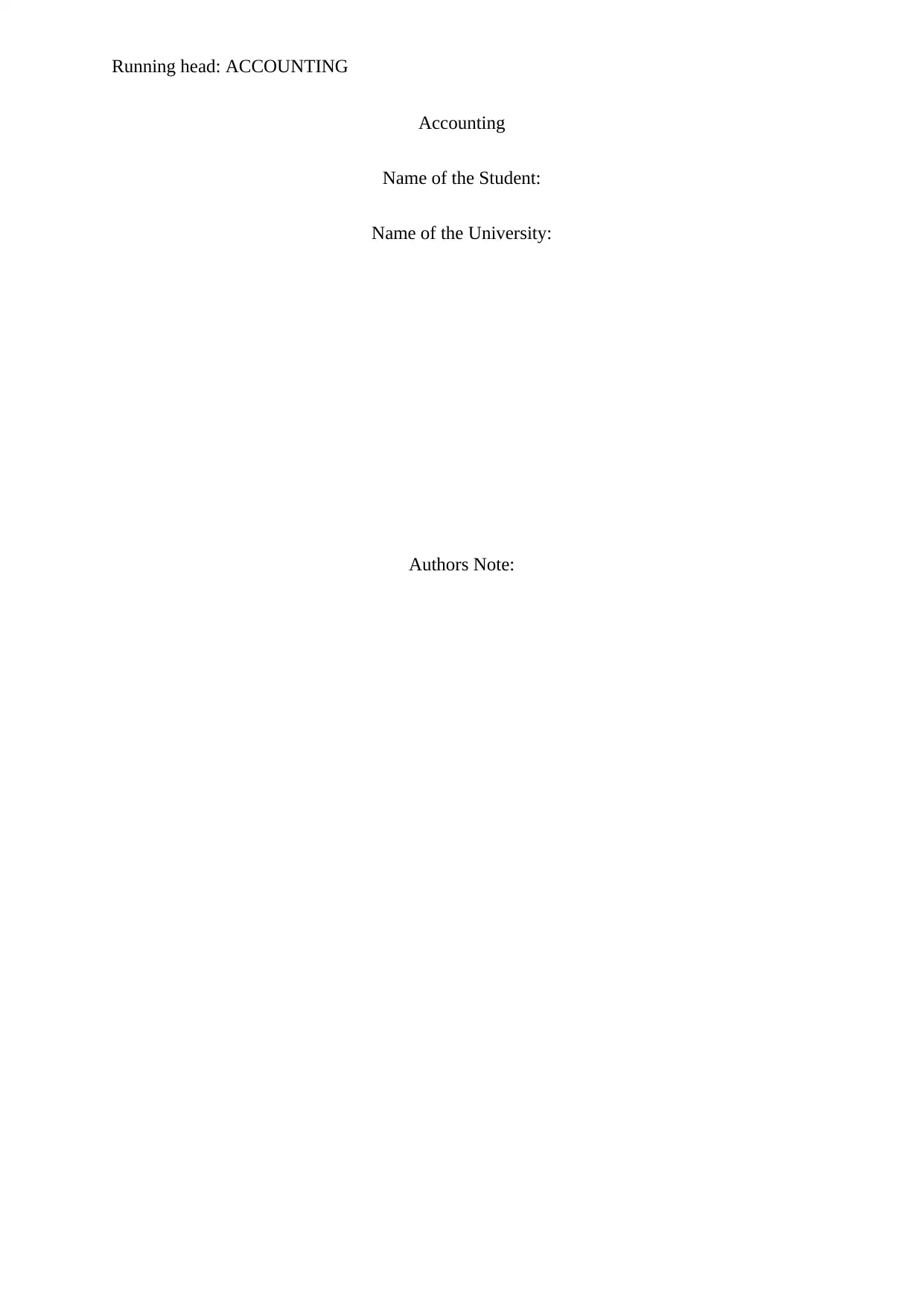
Running head: ACCOUNTING
Accounting
Name of the Student:
Name of the University:
Authors Note:
Accounting
Name of the Student:
Name of the University:
Authors Note:
Paraphrase This Document
Need a fresh take? Get an instant paraphrase of this document with our AI Paraphraser
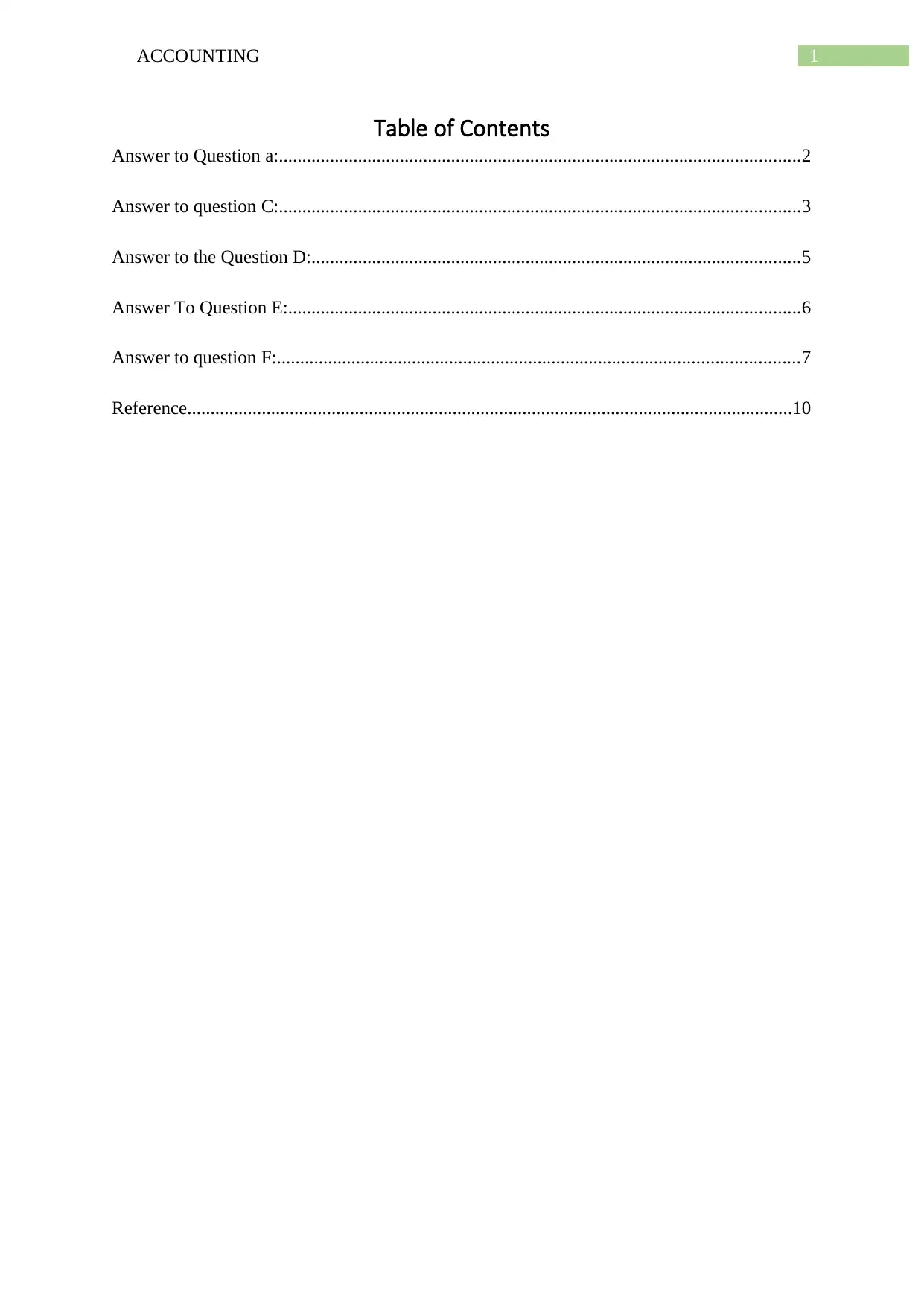
1ACCOUNTING
Table of Contents
Answer to Question a:................................................................................................................2
Answer to question C:................................................................................................................3
Answer to the Question D:.........................................................................................................5
Answer To Question E:..............................................................................................................6
Answer to question F:................................................................................................................7
Reference..................................................................................................................................10
Table of Contents
Answer to Question a:................................................................................................................2
Answer to question C:................................................................................................................3
Answer to the Question D:.........................................................................................................5
Answer To Question E:..............................................................................................................6
Answer to question F:................................................................................................................7
Reference..................................................................................................................................10
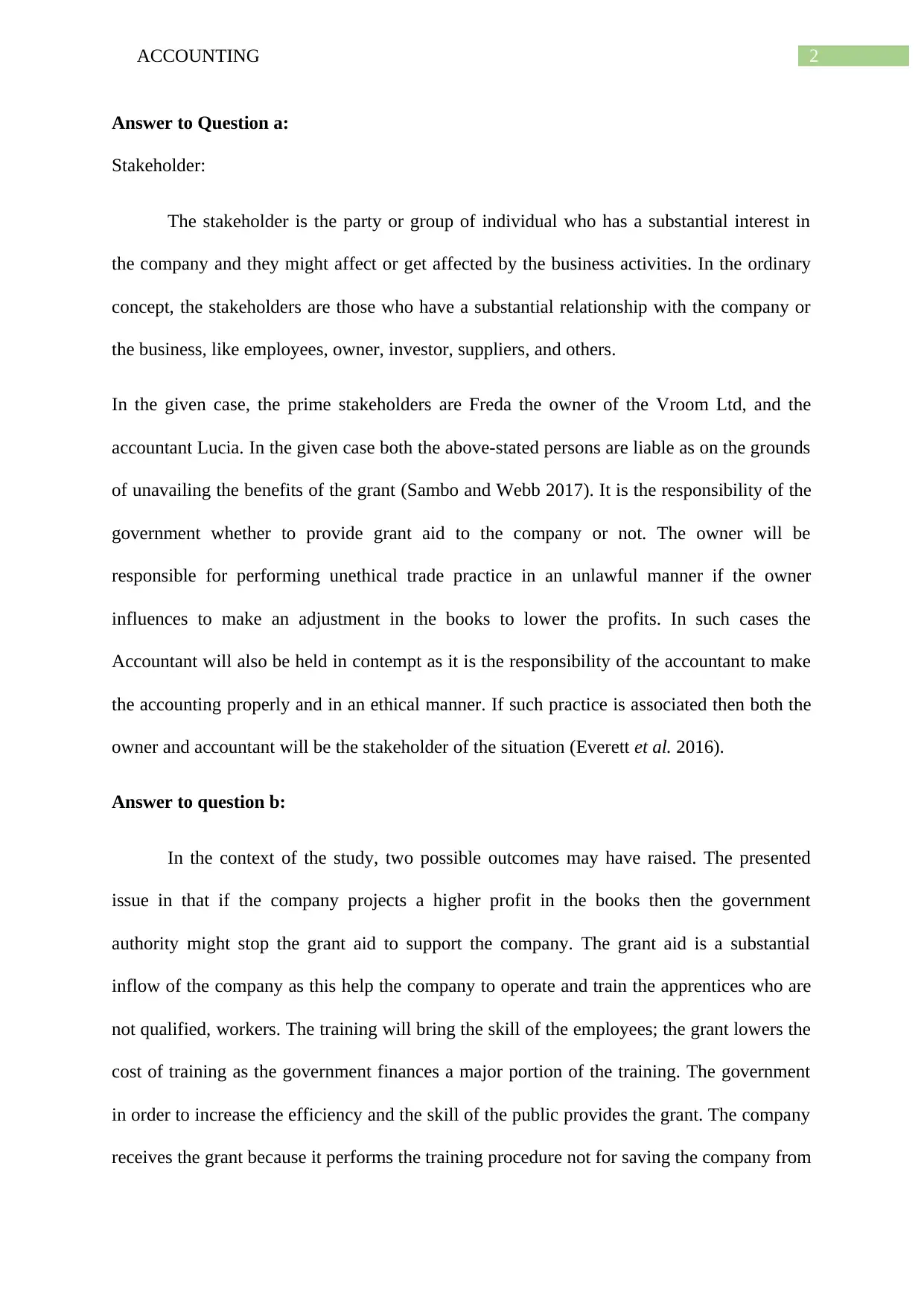
2ACCOUNTING
Answer to Question a:
Stakeholder:
The stakeholder is the party or group of individual who has a substantial interest in
the company and they might affect or get affected by the business activities. In the ordinary
concept, the stakeholders are those who have a substantial relationship with the company or
the business, like employees, owner, investor, suppliers, and others.
In the given case, the prime stakeholders are Freda the owner of the Vroom Ltd, and the
accountant Lucia. In the given case both the above-stated persons are liable as on the grounds
of unavailing the benefits of the grant (Sambo and Webb 2017). It is the responsibility of the
government whether to provide grant aid to the company or not. The owner will be
responsible for performing unethical trade practice in an unlawful manner if the owner
influences to make an adjustment in the books to lower the profits. In such cases the
Accountant will also be held in contempt as it is the responsibility of the accountant to make
the accounting properly and in an ethical manner. If such practice is associated then both the
owner and accountant will be the stakeholder of the situation (Everett et al. 2016).
Answer to question b:
In the context of the study, two possible outcomes may have raised. The presented
issue in that if the company projects a higher profit in the books then the government
authority might stop the grant aid to support the company. The grant aid is a substantial
inflow of the company as this help the company to operate and train the apprentices who are
not qualified, workers. The training will bring the skill of the employees; the grant lowers the
cost of training as the government finances a major portion of the training. The government
in order to increase the efficiency and the skill of the public provides the grant. The company
receives the grant because it performs the training procedure not for saving the company from
Answer to Question a:
Stakeholder:
The stakeholder is the party or group of individual who has a substantial interest in
the company and they might affect or get affected by the business activities. In the ordinary
concept, the stakeholders are those who have a substantial relationship with the company or
the business, like employees, owner, investor, suppliers, and others.
In the given case, the prime stakeholders are Freda the owner of the Vroom Ltd, and the
accountant Lucia. In the given case both the above-stated persons are liable as on the grounds
of unavailing the benefits of the grant (Sambo and Webb 2017). It is the responsibility of the
government whether to provide grant aid to the company or not. The owner will be
responsible for performing unethical trade practice in an unlawful manner if the owner
influences to make an adjustment in the books to lower the profits. In such cases the
Accountant will also be held in contempt as it is the responsibility of the accountant to make
the accounting properly and in an ethical manner. If such practice is associated then both the
owner and accountant will be the stakeholder of the situation (Everett et al. 2016).
Answer to question b:
In the context of the study, two possible outcomes may have raised. The presented
issue in that if the company projects a higher profit in the books then the government
authority might stop the grant aid to support the company. The grant aid is a substantial
inflow of the company as this help the company to operate and train the apprentices who are
not qualified, workers. The training will bring the skill of the employees; the grant lowers the
cost of training as the government finances a major portion of the training. The government
in order to increase the efficiency and the skill of the public provides the grant. The company
receives the grant because it performs the training procedure not for saving the company from
⊘ This is a preview!⊘
Do you want full access?
Subscribe today to unlock all pages.

Trusted by 1+ million students worldwide
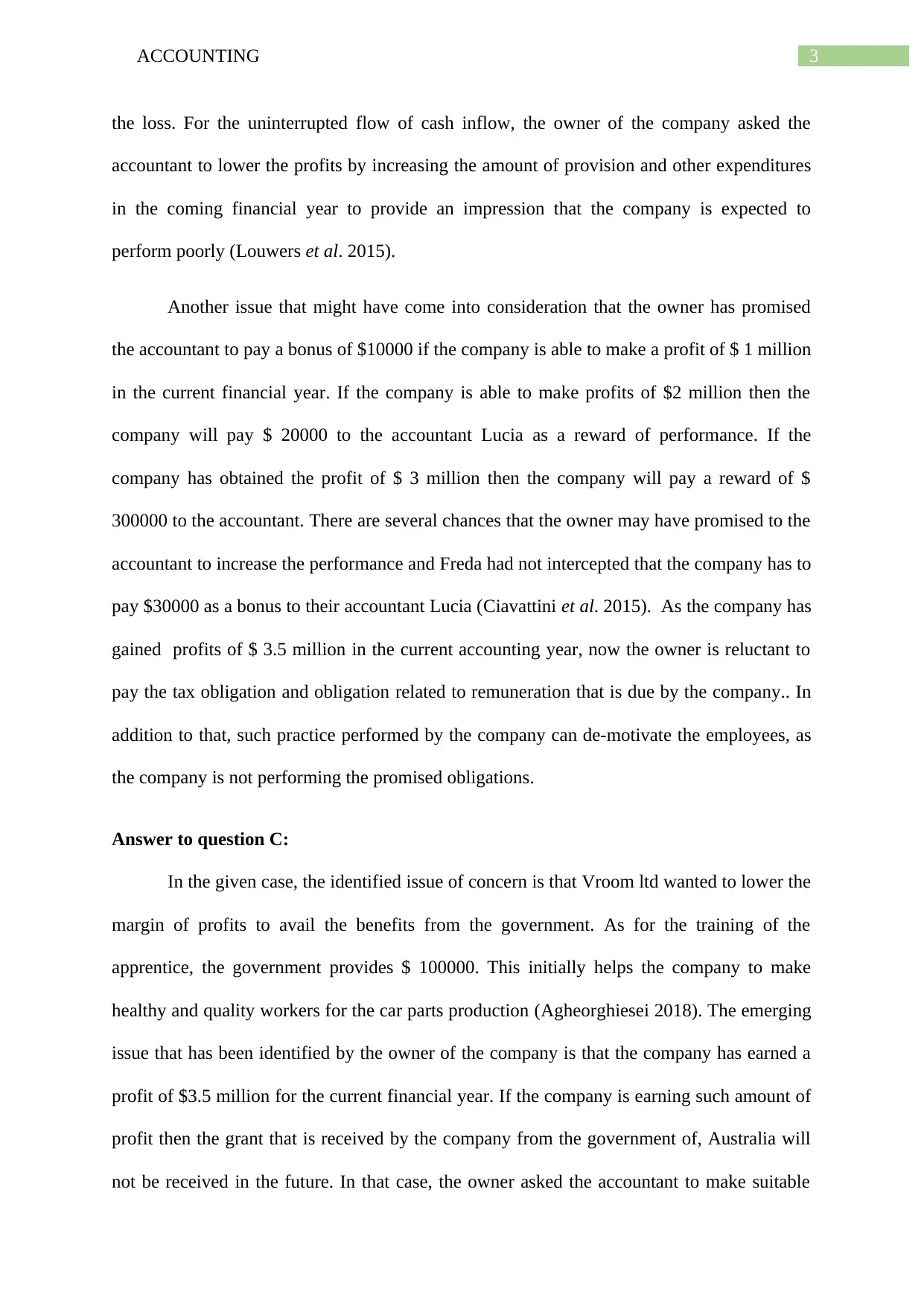
3ACCOUNTING
the loss. For the uninterrupted flow of cash inflow, the owner of the company asked the
accountant to lower the profits by increasing the amount of provision and other expenditures
in the coming financial year to provide an impression that the company is expected to
perform poorly (Louwers et al. 2015).
Another issue that might have come into consideration that the owner has promised
the accountant to pay a bonus of $10000 if the company is able to make a profit of $ 1 million
in the current financial year. If the company is able to make profits of $2 million then the
company will pay $ 20000 to the accountant Lucia as a reward of performance. If the
company has obtained the profit of $ 3 million then the company will pay a reward of $
300000 to the accountant. There are several chances that the owner may have promised to the
accountant to increase the performance and Freda had not intercepted that the company has to
pay $30000 as a bonus to their accountant Lucia (Ciavattini et al. 2015). As the company has
gained profits of $ 3.5 million in the current accounting year, now the owner is reluctant to
pay the tax obligation and obligation related to remuneration that is due by the company.. In
addition to that, such practice performed by the company can de-motivate the employees, as
the company is not performing the promised obligations.
Answer to question C:
In the given case, the identified issue of concern is that Vroom ltd wanted to lower the
margin of profits to avail the benefits from the government. As for the training of the
apprentice, the government provides $ 100000. This initially helps the company to make
healthy and quality workers for the car parts production (Agheorghiesei 2018). The emerging
issue that has been identified by the owner of the company is that the company has earned a
profit of $3.5 million for the current financial year. If the company is earning such amount of
profit then the grant that is received by the company from the government of, Australia will
not be received in the future. In that case, the owner asked the accountant to make suitable
the loss. For the uninterrupted flow of cash inflow, the owner of the company asked the
accountant to lower the profits by increasing the amount of provision and other expenditures
in the coming financial year to provide an impression that the company is expected to
perform poorly (Louwers et al. 2015).
Another issue that might have come into consideration that the owner has promised
the accountant to pay a bonus of $10000 if the company is able to make a profit of $ 1 million
in the current financial year. If the company is able to make profits of $2 million then the
company will pay $ 20000 to the accountant Lucia as a reward of performance. If the
company has obtained the profit of $ 3 million then the company will pay a reward of $
300000 to the accountant. There are several chances that the owner may have promised to the
accountant to increase the performance and Freda had not intercepted that the company has to
pay $30000 as a bonus to their accountant Lucia (Ciavattini et al. 2015). As the company has
gained profits of $ 3.5 million in the current accounting year, now the owner is reluctant to
pay the tax obligation and obligation related to remuneration that is due by the company.. In
addition to that, such practice performed by the company can de-motivate the employees, as
the company is not performing the promised obligations.
Answer to question C:
In the given case, the identified issue of concern is that Vroom ltd wanted to lower the
margin of profits to avail the benefits from the government. As for the training of the
apprentice, the government provides $ 100000. This initially helps the company to make
healthy and quality workers for the car parts production (Agheorghiesei 2018). The emerging
issue that has been identified by the owner of the company is that the company has earned a
profit of $3.5 million for the current financial year. If the company is earning such amount of
profit then the grant that is received by the company from the government of, Australia will
not be received in the future. In that case, the owner asked the accountant to make suitable
Paraphrase This Document
Need a fresh take? Get an instant paraphrase of this document with our AI Paraphraser
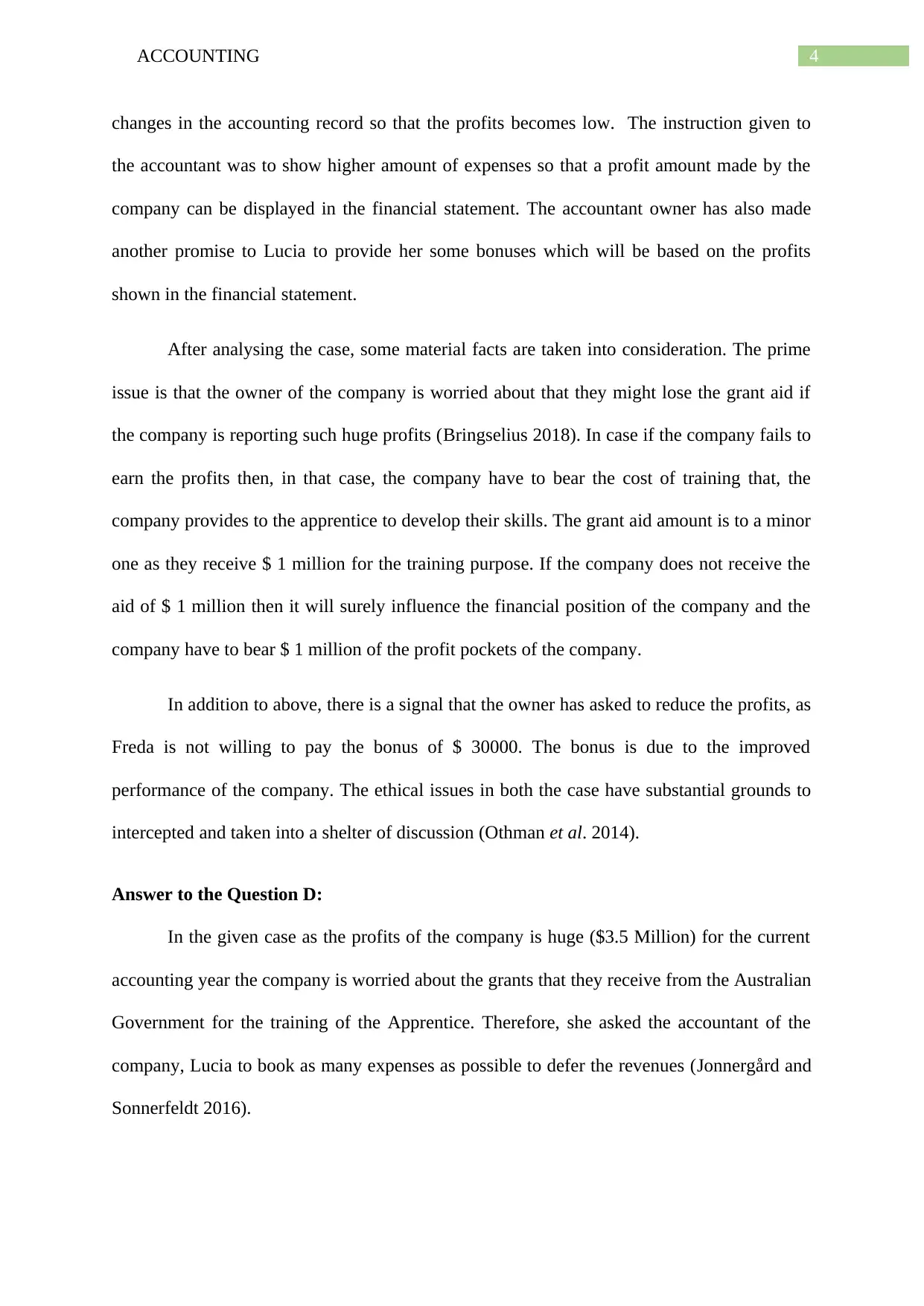
4ACCOUNTING
changes in the accounting record so that the profits becomes low. The instruction given to
the accountant was to show higher amount of expenses so that a profit amount made by the
company can be displayed in the financial statement. The accountant owner has also made
another promise to Lucia to provide her some bonuses which will be based on the profits
shown in the financial statement.
After analysing the case, some material facts are taken into consideration. The prime
issue is that the owner of the company is worried about that they might lose the grant aid if
the company is reporting such huge profits (Bringselius 2018). In case if the company fails to
earn the profits then, in that case, the company have to bear the cost of training that, the
company provides to the apprentice to develop their skills. The grant aid amount is to a minor
one as they receive $ 1 million for the training purpose. If the company does not receive the
aid of $ 1 million then it will surely influence the financial position of the company and the
company have to bear $ 1 million of the profit pockets of the company.
In addition to above, there is a signal that the owner has asked to reduce the profits, as
Freda is not willing to pay the bonus of $ 30000. The bonus is due to the improved
performance of the company. The ethical issues in both the case have substantial grounds to
intercepted and taken into a shelter of discussion (Othman et al. 2014).
Answer to the Question D:
In the given case as the profits of the company is huge ($3.5 Million) for the current
accounting year the company is worried about the grants that they receive from the Australian
Government for the training of the Apprentice. Therefore, she asked the accountant of the
company, Lucia to book as many expenses as possible to defer the revenues (Jonnergård and
Sonnerfeldt 2016).
changes in the accounting record so that the profits becomes low. The instruction given to
the accountant was to show higher amount of expenses so that a profit amount made by the
company can be displayed in the financial statement. The accountant owner has also made
another promise to Lucia to provide her some bonuses which will be based on the profits
shown in the financial statement.
After analysing the case, some material facts are taken into consideration. The prime
issue is that the owner of the company is worried about that they might lose the grant aid if
the company is reporting such huge profits (Bringselius 2018). In case if the company fails to
earn the profits then, in that case, the company have to bear the cost of training that, the
company provides to the apprentice to develop their skills. The grant aid amount is to a minor
one as they receive $ 1 million for the training purpose. If the company does not receive the
aid of $ 1 million then it will surely influence the financial position of the company and the
company have to bear $ 1 million of the profit pockets of the company.
In addition to above, there is a signal that the owner has asked to reduce the profits, as
Freda is not willing to pay the bonus of $ 30000. The bonus is due to the improved
performance of the company. The ethical issues in both the case have substantial grounds to
intercepted and taken into a shelter of discussion (Othman et al. 2014).
Answer to the Question D:
In the given case as the profits of the company is huge ($3.5 Million) for the current
accounting year the company is worried about the grants that they receive from the Australian
Government for the training of the Apprentice. Therefore, she asked the accountant of the
company, Lucia to book as many expenses as possible to defer the revenues (Jonnergård and
Sonnerfeldt 2016).
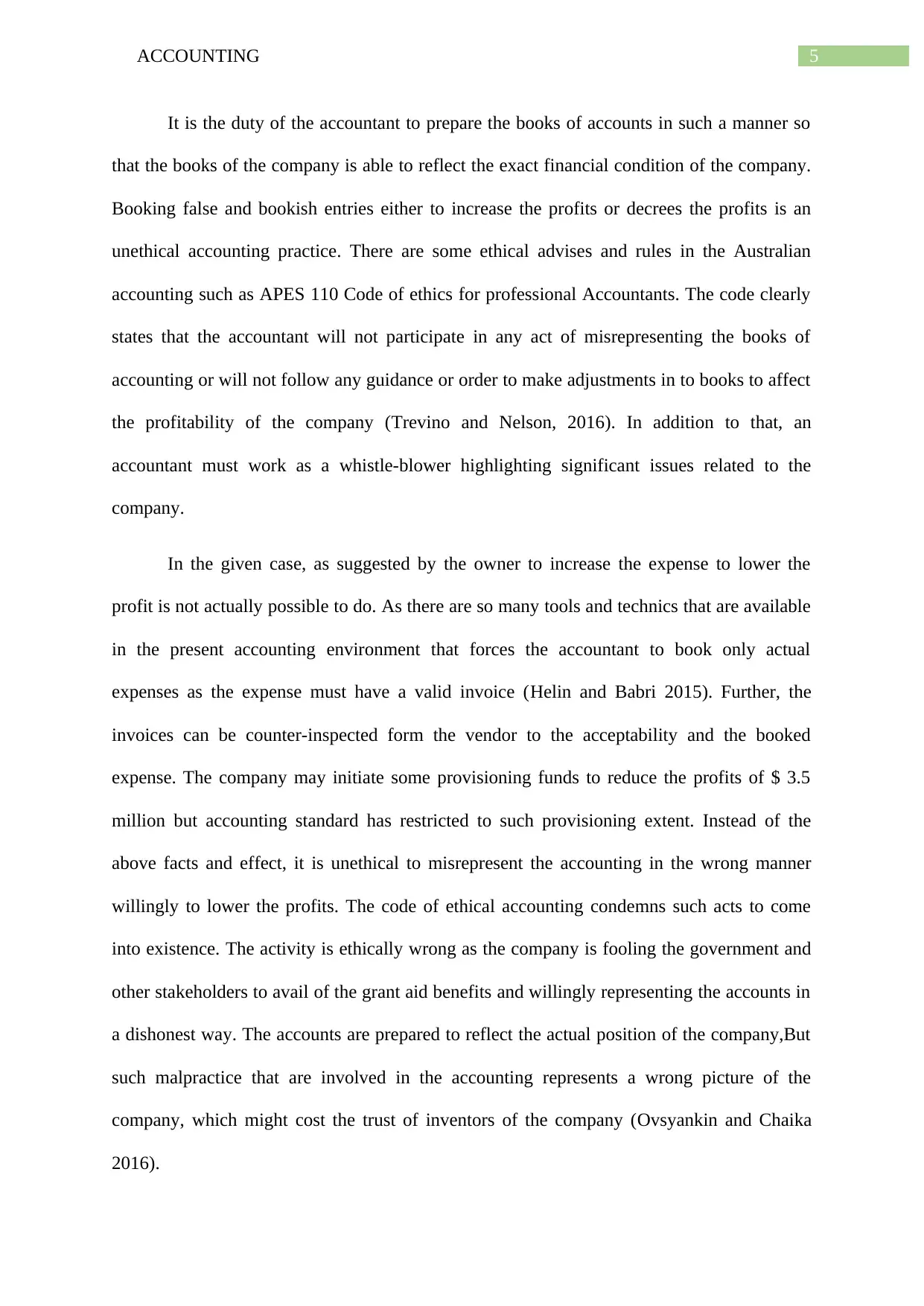
5ACCOUNTING
It is the duty of the accountant to prepare the books of accounts in such a manner so
that the books of the company is able to reflect the exact financial condition of the company.
Booking false and bookish entries either to increase the profits or decrees the profits is an
unethical accounting practice. There are some ethical advises and rules in the Australian
accounting such as APES 110 Code of ethics for professional Accountants. The code clearly
states that the accountant will not participate in any act of misrepresenting the books of
accounting or will not follow any guidance or order to make adjustments in to books to affect
the profitability of the company (Trevino and Nelson, 2016). In addition to that, an
accountant must work as a whistle-blower highlighting significant issues related to the
company.
In the given case, as suggested by the owner to increase the expense to lower the
profit is not actually possible to do. As there are so many tools and technics that are available
in the present accounting environment that forces the accountant to book only actual
expenses as the expense must have a valid invoice (Helin and Babri 2015). Further, the
invoices can be counter-inspected form the vendor to the acceptability and the booked
expense. The company may initiate some provisioning funds to reduce the profits of $ 3.5
million but accounting standard has restricted to such provisioning extent. Instead of the
above facts and effect, it is unethical to misrepresent the accounting in the wrong manner
willingly to lower the profits. The code of ethical accounting condemns such acts to come
into existence. The activity is ethically wrong as the company is fooling the government and
other stakeholders to avail of the grant aid benefits and willingly representing the accounts in
a dishonest way. The accounts are prepared to reflect the actual position of the company,But
such malpractice that are involved in the accounting represents a wrong picture of the
company, which might cost the trust of inventors of the company (Ovsyankin and Chaika
2016).
It is the duty of the accountant to prepare the books of accounts in such a manner so
that the books of the company is able to reflect the exact financial condition of the company.
Booking false and bookish entries either to increase the profits or decrees the profits is an
unethical accounting practice. There are some ethical advises and rules in the Australian
accounting such as APES 110 Code of ethics for professional Accountants. The code clearly
states that the accountant will not participate in any act of misrepresenting the books of
accounting or will not follow any guidance or order to make adjustments in to books to affect
the profitability of the company (Trevino and Nelson, 2016). In addition to that, an
accountant must work as a whistle-blower highlighting significant issues related to the
company.
In the given case, as suggested by the owner to increase the expense to lower the
profit is not actually possible to do. As there are so many tools and technics that are available
in the present accounting environment that forces the accountant to book only actual
expenses as the expense must have a valid invoice (Helin and Babri 2015). Further, the
invoices can be counter-inspected form the vendor to the acceptability and the booked
expense. The company may initiate some provisioning funds to reduce the profits of $ 3.5
million but accounting standard has restricted to such provisioning extent. Instead of the
above facts and effect, it is unethical to misrepresent the accounting in the wrong manner
willingly to lower the profits. The code of ethical accounting condemns such acts to come
into existence. The activity is ethically wrong as the company is fooling the government and
other stakeholders to avail of the grant aid benefits and willingly representing the accounts in
a dishonest way. The accounts are prepared to reflect the actual position of the company,But
such malpractice that are involved in the accounting represents a wrong picture of the
company, which might cost the trust of inventors of the company (Ovsyankin and Chaika
2016).
⊘ This is a preview!⊘
Do you want full access?
Subscribe today to unlock all pages.

Trusted by 1+ million students worldwide
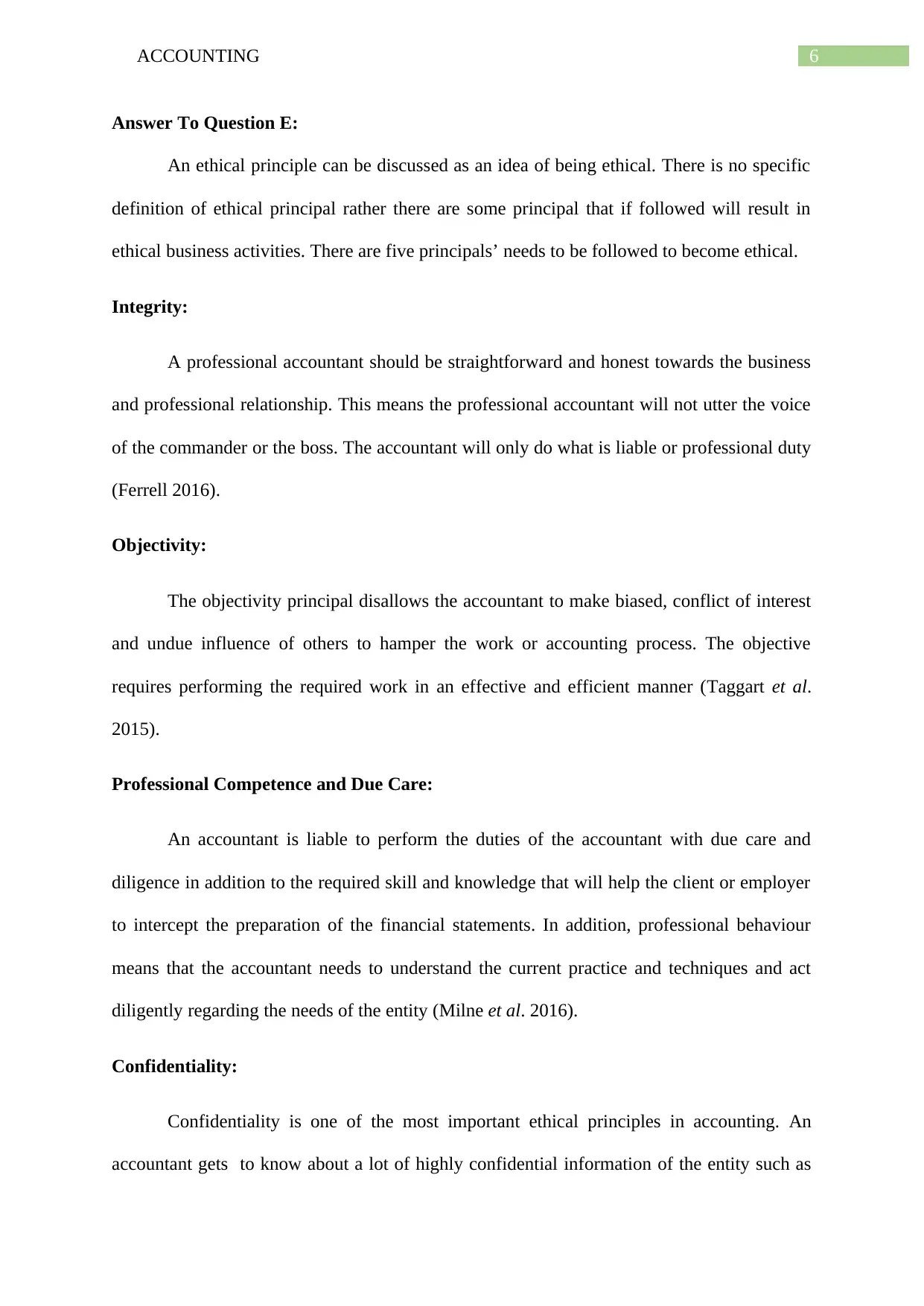
6ACCOUNTING
Answer To Question E:
An ethical principle can be discussed as an idea of being ethical. There is no specific
definition of ethical principal rather there are some principal that if followed will result in
ethical business activities. There are five principals’ needs to be followed to become ethical.
Integrity:
A professional accountant should be straightforward and honest towards the business
and professional relationship. This means the professional accountant will not utter the voice
of the commander or the boss. The accountant will only do what is liable or professional duty
(Ferrell 2016).
Objectivity:
The objectivity principal disallows the accountant to make biased, conflict of interest
and undue influence of others to hamper the work or accounting process. The objective
requires performing the required work in an effective and efficient manner (Taggart et al.
2015).
Professional Competence and Due Care:
An accountant is liable to perform the duties of the accountant with due care and
diligence in addition to the required skill and knowledge that will help the client or employer
to intercept the preparation of the financial statements. In addition, professional behaviour
means that the accountant needs to understand the current practice and techniques and act
diligently regarding the needs of the entity (Milne et al. 2016).
Confidentiality:
Confidentiality is one of the most important ethical principles in accounting. An
accountant gets to know about a lot of highly confidential information of the entity such as
Answer To Question E:
An ethical principle can be discussed as an idea of being ethical. There is no specific
definition of ethical principal rather there are some principal that if followed will result in
ethical business activities. There are five principals’ needs to be followed to become ethical.
Integrity:
A professional accountant should be straightforward and honest towards the business
and professional relationship. This means the professional accountant will not utter the voice
of the commander or the boss. The accountant will only do what is liable or professional duty
(Ferrell 2016).
Objectivity:
The objectivity principal disallows the accountant to make biased, conflict of interest
and undue influence of others to hamper the work or accounting process. The objective
requires performing the required work in an effective and efficient manner (Taggart et al.
2015).
Professional Competence and Due Care:
An accountant is liable to perform the duties of the accountant with due care and
diligence in addition to the required skill and knowledge that will help the client or employer
to intercept the preparation of the financial statements. In addition, professional behaviour
means that the accountant needs to understand the current practice and techniques and act
diligently regarding the needs of the entity (Milne et al. 2016).
Confidentiality:
Confidentiality is one of the most important ethical principles in accounting. An
accountant gets to know about a lot of highly confidential information of the entity such as
Paraphrase This Document
Need a fresh take? Get an instant paraphrase of this document with our AI Paraphraser
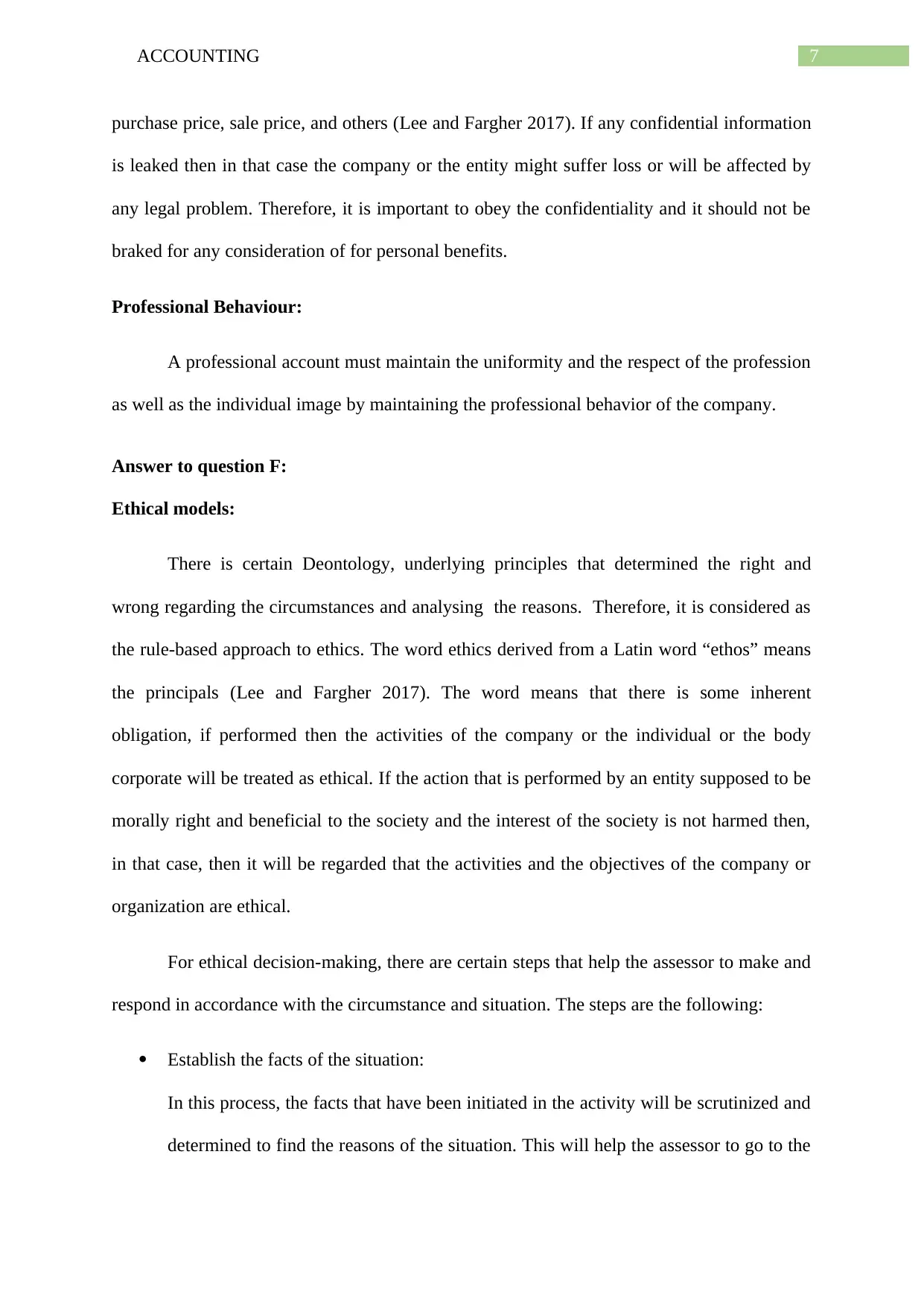
7ACCOUNTING
purchase price, sale price, and others (Lee and Fargher 2017). If any confidential information
is leaked then in that case the company or the entity might suffer loss or will be affected by
any legal problem. Therefore, it is important to obey the confidentiality and it should not be
braked for any consideration of for personal benefits.
Professional Behaviour:
A professional account must maintain the uniformity and the respect of the profession
as well as the individual image by maintaining the professional behavior of the company.
Answer to question F:
Ethical models:
There is certain Deontology, underlying principles that determined the right and
wrong regarding the circumstances and analysing the reasons. Therefore, it is considered as
the rule-based approach to ethics. The word ethics derived from a Latin word “ethos” means
the principals (Lee and Fargher 2017). The word means that there is some inherent
obligation, if performed then the activities of the company or the individual or the body
corporate will be treated as ethical. If the action that is performed by an entity supposed to be
morally right and beneficial to the society and the interest of the society is not harmed then,
in that case, then it will be regarded that the activities and the objectives of the company or
organization are ethical.
For ethical decision-making, there are certain steps that help the assessor to make and
respond in accordance with the circumstance and situation. The steps are the following:
Establish the facts of the situation:
In this process, the facts that have been initiated in the activity will be scrutinized and
determined to find the reasons of the situation. This will help the assessor to go to the
purchase price, sale price, and others (Lee and Fargher 2017). If any confidential information
is leaked then in that case the company or the entity might suffer loss or will be affected by
any legal problem. Therefore, it is important to obey the confidentiality and it should not be
braked for any consideration of for personal benefits.
Professional Behaviour:
A professional account must maintain the uniformity and the respect of the profession
as well as the individual image by maintaining the professional behavior of the company.
Answer to question F:
Ethical models:
There is certain Deontology, underlying principles that determined the right and
wrong regarding the circumstances and analysing the reasons. Therefore, it is considered as
the rule-based approach to ethics. The word ethics derived from a Latin word “ethos” means
the principals (Lee and Fargher 2017). The word means that there is some inherent
obligation, if performed then the activities of the company or the individual or the body
corporate will be treated as ethical. If the action that is performed by an entity supposed to be
morally right and beneficial to the society and the interest of the society is not harmed then,
in that case, then it will be regarded that the activities and the objectives of the company or
organization are ethical.
For ethical decision-making, there are certain steps that help the assessor to make and
respond in accordance with the circumstance and situation. The steps are the following:
Establish the facts of the situation:
In this process, the facts that have been initiated in the activity will be scrutinized and
determined to find the reasons of the situation. This will help the assessor to go to the
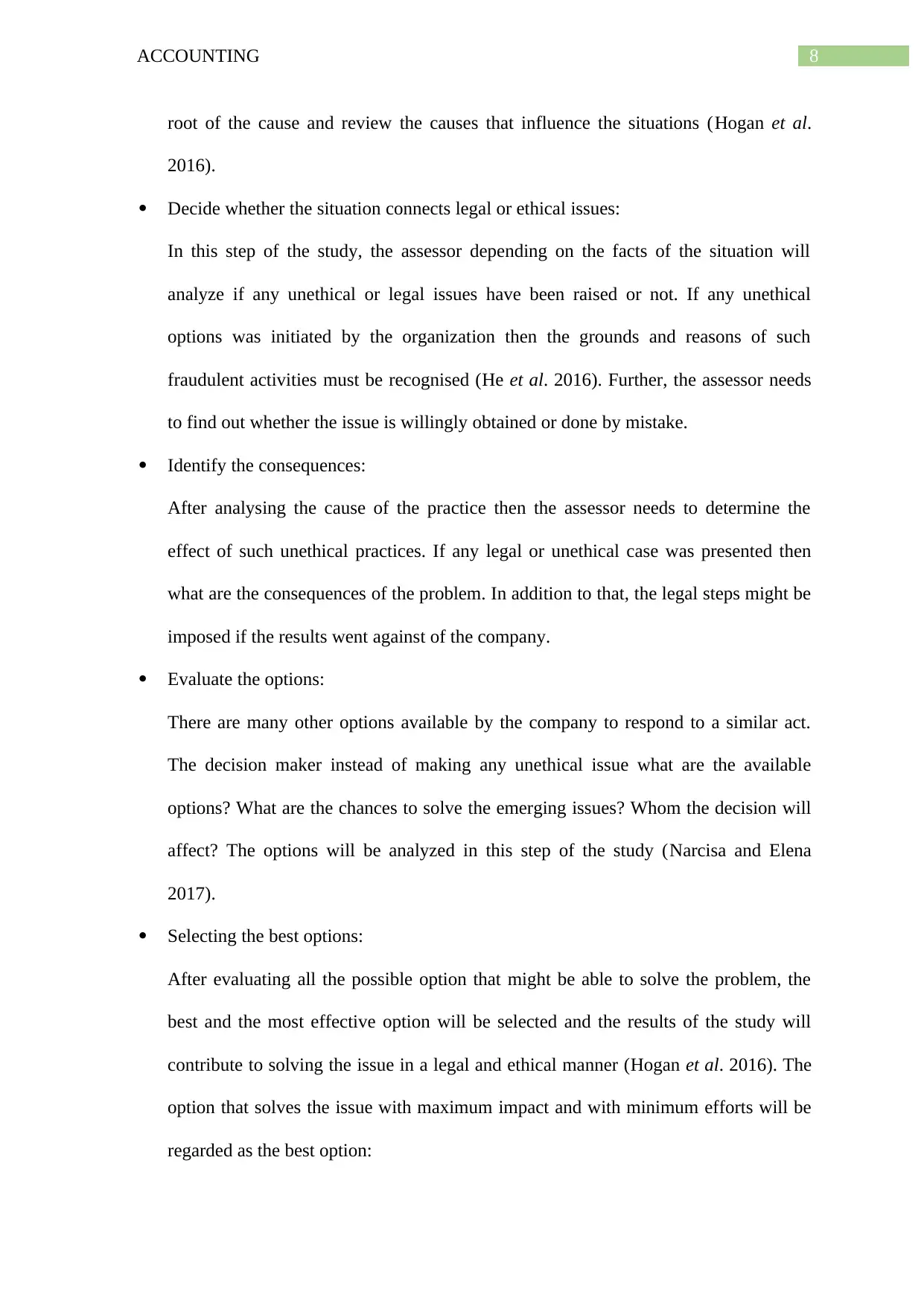
8ACCOUNTING
root of the cause and review the causes that influence the situations (Hogan et al.
2016).
Decide whether the situation connects legal or ethical issues:
In this step of the study, the assessor depending on the facts of the situation will
analyze if any unethical or legal issues have been raised or not. If any unethical
options was initiated by the organization then the grounds and reasons of such
fraudulent activities must be recognised (He et al. 2016). Further, the assessor needs
to find out whether the issue is willingly obtained or done by mistake.
Identify the consequences:
After analysing the cause of the practice then the assessor needs to determine the
effect of such unethical practices. If any legal or unethical case was presented then
what are the consequences of the problem. In addition to that, the legal steps might be
imposed if the results went against of the company.
Evaluate the options:
There are many other options available by the company to respond to a similar act.
The decision maker instead of making any unethical issue what are the available
options? What are the chances to solve the emerging issues? Whom the decision will
affect? The options will be analyzed in this step of the study (Narcisa and Elena
2017).
Selecting the best options:
After evaluating all the possible option that might be able to solve the problem, the
best and the most effective option will be selected and the results of the study will
contribute to solving the issue in a legal and ethical manner (Hogan et al. 2016). The
option that solves the issue with maximum impact and with minimum efforts will be
regarded as the best option:
root of the cause and review the causes that influence the situations (Hogan et al.
2016).
Decide whether the situation connects legal or ethical issues:
In this step of the study, the assessor depending on the facts of the situation will
analyze if any unethical or legal issues have been raised or not. If any unethical
options was initiated by the organization then the grounds and reasons of such
fraudulent activities must be recognised (He et al. 2016). Further, the assessor needs
to find out whether the issue is willingly obtained or done by mistake.
Identify the consequences:
After analysing the cause of the practice then the assessor needs to determine the
effect of such unethical practices. If any legal or unethical case was presented then
what are the consequences of the problem. In addition to that, the legal steps might be
imposed if the results went against of the company.
Evaluate the options:
There are many other options available by the company to respond to a similar act.
The decision maker instead of making any unethical issue what are the available
options? What are the chances to solve the emerging issues? Whom the decision will
affect? The options will be analyzed in this step of the study (Narcisa and Elena
2017).
Selecting the best options:
After evaluating all the possible option that might be able to solve the problem, the
best and the most effective option will be selected and the results of the study will
contribute to solving the issue in a legal and ethical manner (Hogan et al. 2016). The
option that solves the issue with maximum impact and with minimum efforts will be
regarded as the best option:
⊘ This is a preview!⊘
Do you want full access?
Subscribe today to unlock all pages.

Trusted by 1+ million students worldwide
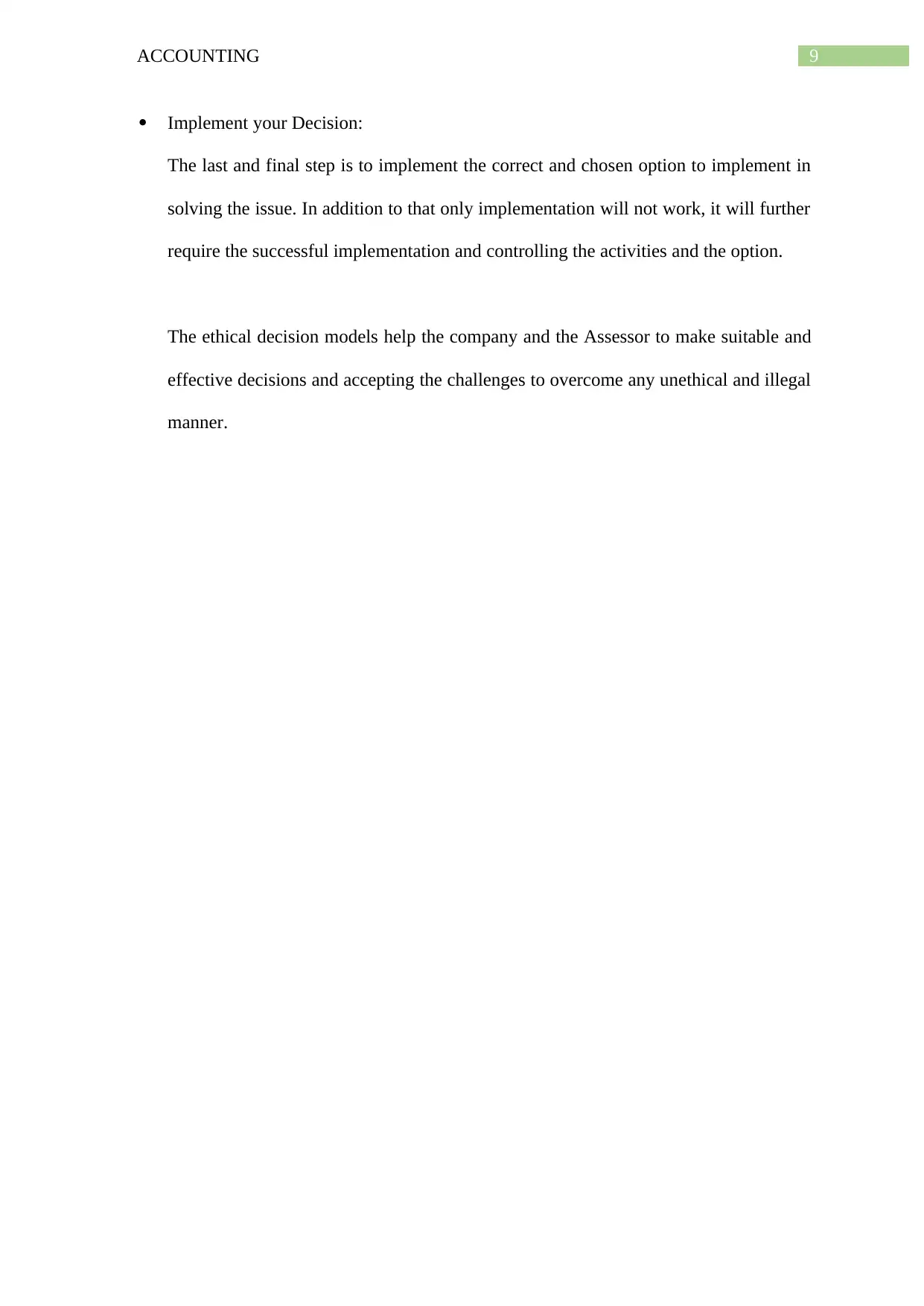
9ACCOUNTING
Implement your Decision:
The last and final step is to implement the correct and chosen option to implement in
solving the issue. In addition to that only implementation will not work, it will further
require the successful implementation and controlling the activities and the option.
The ethical decision models help the company and the Assessor to make suitable and
effective decisions and accepting the challenges to overcome any unethical and illegal
manner.
Implement your Decision:
The last and final step is to implement the correct and chosen option to implement in
solving the issue. In addition to that only implementation will not work, it will further
require the successful implementation and controlling the activities and the option.
The ethical decision models help the company and the Assessor to make suitable and
effective decisions and accepting the challenges to overcome any unethical and illegal
manner.
Paraphrase This Document
Need a fresh take? Get an instant paraphrase of this document with our AI Paraphraser
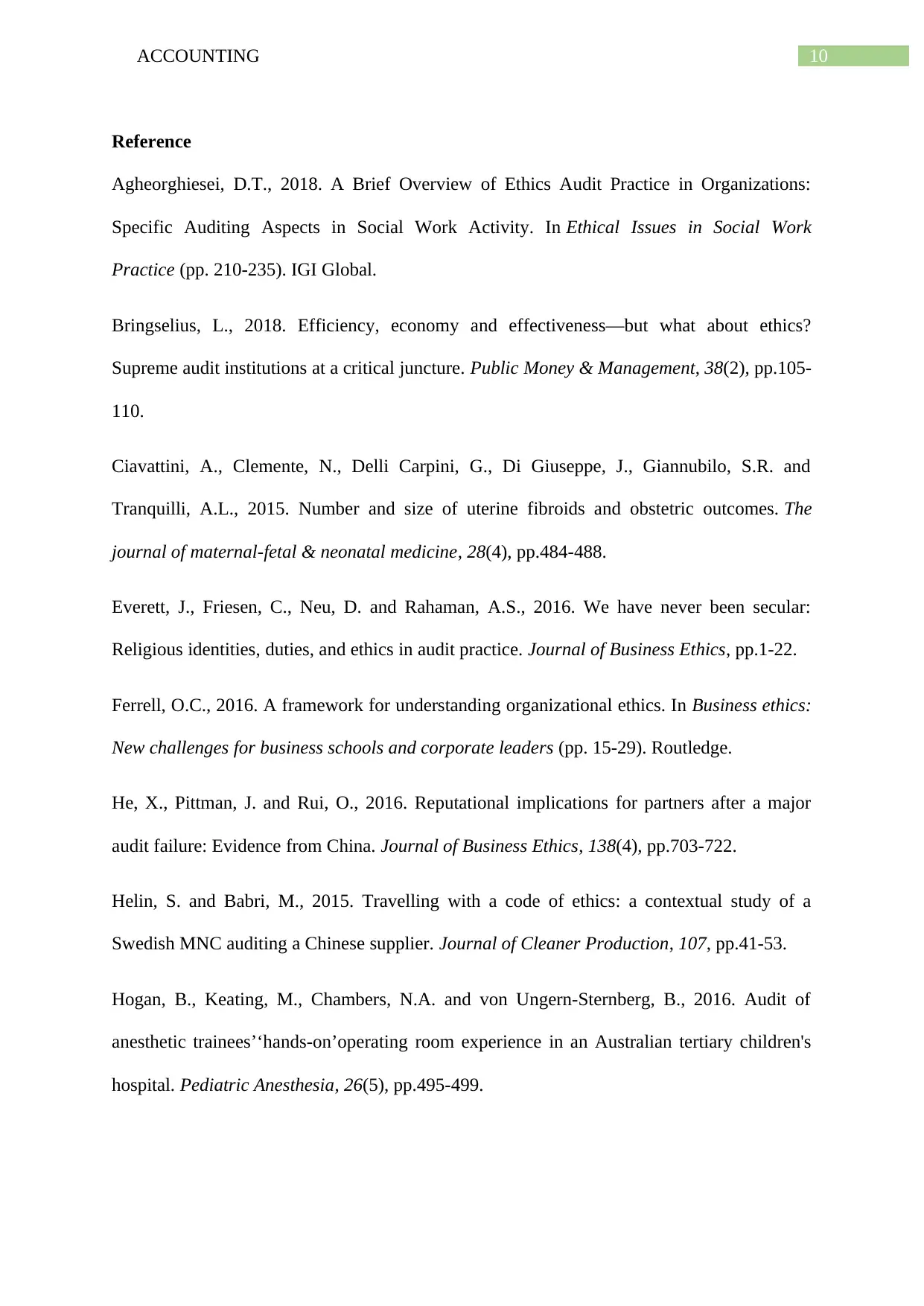
10ACCOUNTING
Reference
Agheorghiesei, D.T., 2018. A Brief Overview of Ethics Audit Practice in Organizations:
Specific Auditing Aspects in Social Work Activity. In Ethical Issues in Social Work
Practice (pp. 210-235). IGI Global.
Bringselius, L., 2018. Efficiency, economy and effectiveness—but what about ethics?
Supreme audit institutions at a critical juncture. Public Money & Management, 38(2), pp.105-
110.
Ciavattini, A., Clemente, N., Delli Carpini, G., Di Giuseppe, J., Giannubilo, S.R. and
Tranquilli, A.L., 2015. Number and size of uterine fibroids and obstetric outcomes. The
journal of maternal-fetal & neonatal medicine, 28(4), pp.484-488.
Everett, J., Friesen, C., Neu, D. and Rahaman, A.S., 2016. We have never been secular:
Religious identities, duties, and ethics in audit practice. Journal of Business Ethics, pp.1-22.
Ferrell, O.C., 2016. A framework for understanding organizational ethics. In Business ethics:
New challenges for business schools and corporate leaders (pp. 15-29). Routledge.
He, X., Pittman, J. and Rui, O., 2016. Reputational implications for partners after a major
audit failure: Evidence from China. Journal of Business Ethics, 138(4), pp.703-722.
Helin, S. and Babri, M., 2015. Travelling with a code of ethics: a contextual study of a
Swedish MNC auditing a Chinese supplier. Journal of Cleaner Production, 107, pp.41-53.
Hogan, B., Keating, M., Chambers, N.A. and von Ungern‐Sternberg, B., 2016. Audit of
anesthetic trainees’‘hands‐on’operating room experience in an Australian tertiary children's
hospital. Pediatric Anesthesia, 26(5), pp.495-499.
Reference
Agheorghiesei, D.T., 2018. A Brief Overview of Ethics Audit Practice in Organizations:
Specific Auditing Aspects in Social Work Activity. In Ethical Issues in Social Work
Practice (pp. 210-235). IGI Global.
Bringselius, L., 2018. Efficiency, economy and effectiveness—but what about ethics?
Supreme audit institutions at a critical juncture. Public Money & Management, 38(2), pp.105-
110.
Ciavattini, A., Clemente, N., Delli Carpini, G., Di Giuseppe, J., Giannubilo, S.R. and
Tranquilli, A.L., 2015. Number and size of uterine fibroids and obstetric outcomes. The
journal of maternal-fetal & neonatal medicine, 28(4), pp.484-488.
Everett, J., Friesen, C., Neu, D. and Rahaman, A.S., 2016. We have never been secular:
Religious identities, duties, and ethics in audit practice. Journal of Business Ethics, pp.1-22.
Ferrell, O.C., 2016. A framework for understanding organizational ethics. In Business ethics:
New challenges for business schools and corporate leaders (pp. 15-29). Routledge.
He, X., Pittman, J. and Rui, O., 2016. Reputational implications for partners after a major
audit failure: Evidence from China. Journal of Business Ethics, 138(4), pp.703-722.
Helin, S. and Babri, M., 2015. Travelling with a code of ethics: a contextual study of a
Swedish MNC auditing a Chinese supplier. Journal of Cleaner Production, 107, pp.41-53.
Hogan, B., Keating, M., Chambers, N.A. and von Ungern‐Sternberg, B., 2016. Audit of
anesthetic trainees’‘hands‐on’operating room experience in an Australian tertiary children's
hospital. Pediatric Anesthesia, 26(5), pp.495-499.
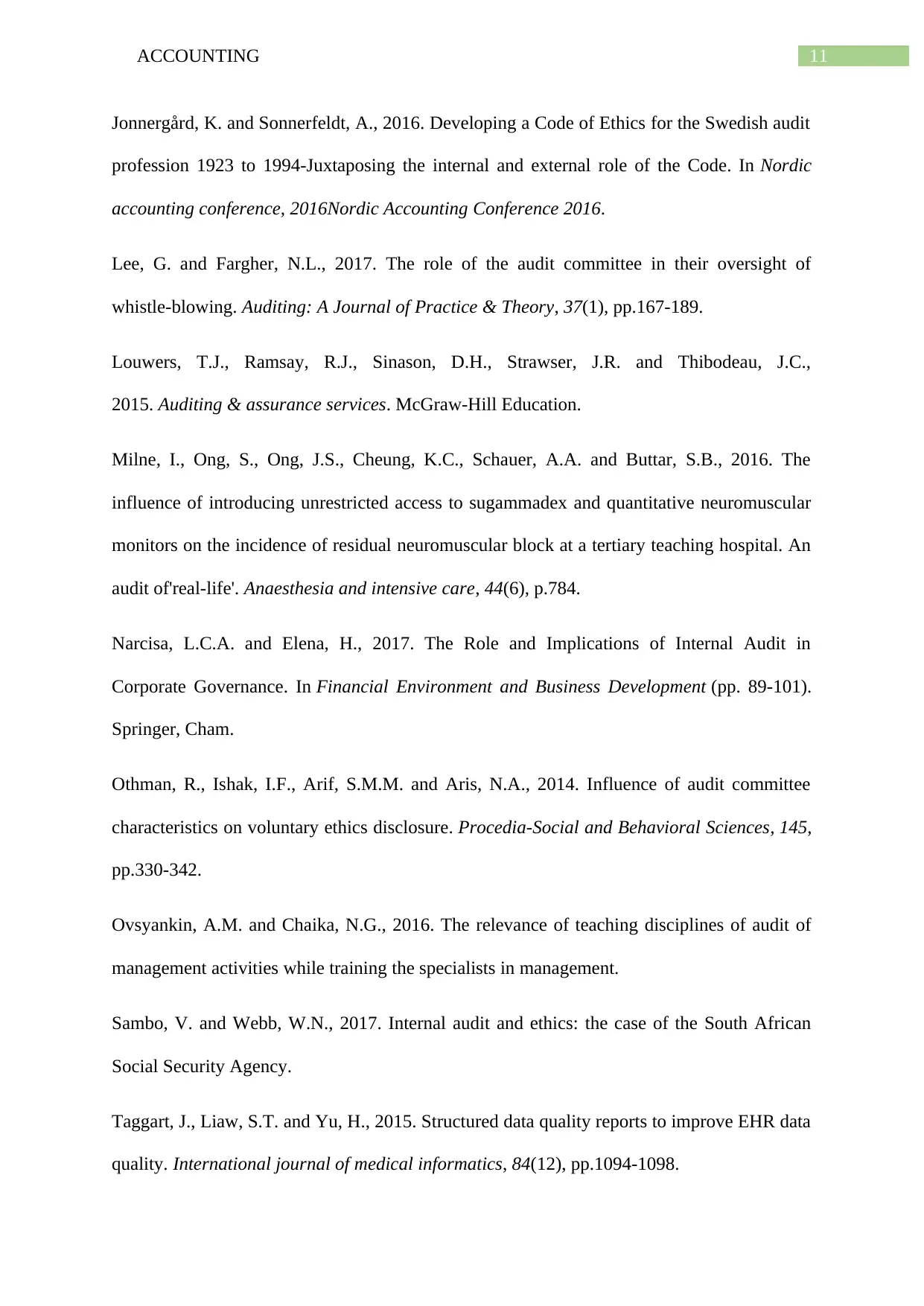
11ACCOUNTING
Jonnergård, K. and Sonnerfeldt, A., 2016. Developing a Code of Ethics for the Swedish audit
profession 1923 to 1994-Juxtaposing the internal and external role of the Code. In Nordic
accounting conference, 2016Nordic Accounting Conference 2016.
Lee, G. and Fargher, N.L., 2017. The role of the audit committee in their oversight of
whistle-blowing. Auditing: A Journal of Practice & Theory, 37(1), pp.167-189.
Louwers, T.J., Ramsay, R.J., Sinason, D.H., Strawser, J.R. and Thibodeau, J.C.,
2015. Auditing & assurance services. McGraw-Hill Education.
Milne, I., Ong, S., Ong, J.S., Cheung, K.C., Schauer, A.A. and Buttar, S.B., 2016. The
influence of introducing unrestricted access to sugammadex and quantitative neuromuscular
monitors on the incidence of residual neuromuscular block at a tertiary teaching hospital. An
audit of'real-life'. Anaesthesia and intensive care, 44(6), p.784.
Narcisa, L.C.A. and Elena, H., 2017. The Role and Implications of Internal Audit in
Corporate Governance. In Financial Environment and Business Development (pp. 89-101).
Springer, Cham.
Othman, R., Ishak, I.F., Arif, S.M.M. and Aris, N.A., 2014. Influence of audit committee
characteristics on voluntary ethics disclosure. Procedia-Social and Behavioral Sciences, 145,
pp.330-342.
Ovsyankin, A.M. and Chaika, N.G., 2016. The relevance of teaching disciplines of audit of
management activities while training the specialists in management.
Sambo, V. and Webb, W.N., 2017. Internal audit and ethics: the case of the South African
Social Security Agency.
Taggart, J., Liaw, S.T. and Yu, H., 2015. Structured data quality reports to improve EHR data
quality. International journal of medical informatics, 84(12), pp.1094-1098.
Jonnergård, K. and Sonnerfeldt, A., 2016. Developing a Code of Ethics for the Swedish audit
profession 1923 to 1994-Juxtaposing the internal and external role of the Code. In Nordic
accounting conference, 2016Nordic Accounting Conference 2016.
Lee, G. and Fargher, N.L., 2017. The role of the audit committee in their oversight of
whistle-blowing. Auditing: A Journal of Practice & Theory, 37(1), pp.167-189.
Louwers, T.J., Ramsay, R.J., Sinason, D.H., Strawser, J.R. and Thibodeau, J.C.,
2015. Auditing & assurance services. McGraw-Hill Education.
Milne, I., Ong, S., Ong, J.S., Cheung, K.C., Schauer, A.A. and Buttar, S.B., 2016. The
influence of introducing unrestricted access to sugammadex and quantitative neuromuscular
monitors on the incidence of residual neuromuscular block at a tertiary teaching hospital. An
audit of'real-life'. Anaesthesia and intensive care, 44(6), p.784.
Narcisa, L.C.A. and Elena, H., 2017. The Role and Implications of Internal Audit in
Corporate Governance. In Financial Environment and Business Development (pp. 89-101).
Springer, Cham.
Othman, R., Ishak, I.F., Arif, S.M.M. and Aris, N.A., 2014. Influence of audit committee
characteristics on voluntary ethics disclosure. Procedia-Social and Behavioral Sciences, 145,
pp.330-342.
Ovsyankin, A.M. and Chaika, N.G., 2016. The relevance of teaching disciplines of audit of
management activities while training the specialists in management.
Sambo, V. and Webb, W.N., 2017. Internal audit and ethics: the case of the South African
Social Security Agency.
Taggart, J., Liaw, S.T. and Yu, H., 2015. Structured data quality reports to improve EHR data
quality. International journal of medical informatics, 84(12), pp.1094-1098.
⊘ This is a preview!⊘
Do you want full access?
Subscribe today to unlock all pages.

Trusted by 1+ million students worldwide
1 out of 13
Related Documents
Your All-in-One AI-Powered Toolkit for Academic Success.
+13062052269
info@desklib.com
Available 24*7 on WhatsApp / Email
![[object Object]](/_next/static/media/star-bottom.7253800d.svg)
Unlock your academic potential
Copyright © 2020–2025 A2Z Services. All Rights Reserved. Developed and managed by ZUCOL.





